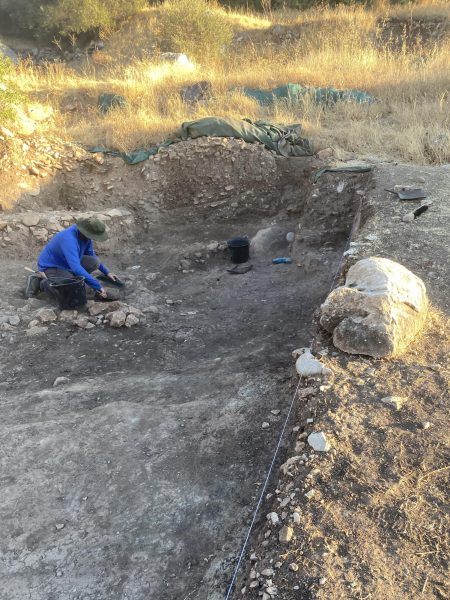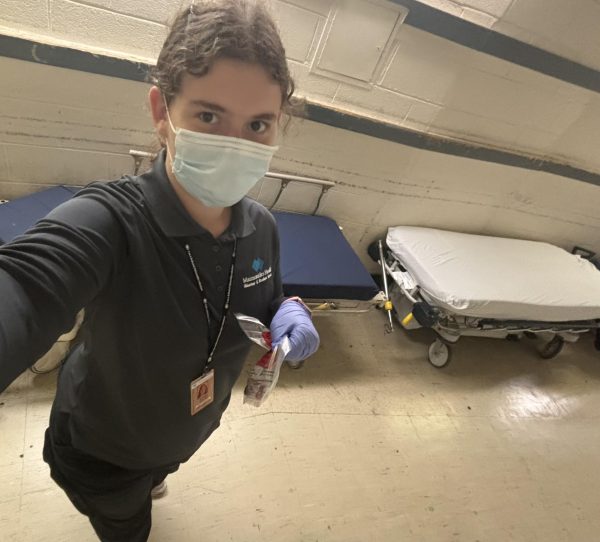Reduce, Reuse, Recycle, Ramaz: A Spotlight on The Environmental Club

The Ramaz Environmental Club’s mission is to “green” the school by spreading awareness about environmental concerns and adopting sustainable habits. The Luv Your Lulav drive and Ramaz reusable water bottles are just some of the projects the club has developed over the past few years. The club also planted daffodil bulbs donated by the Daffodil Project commemorating 9/11, began a book-swap and battery drive in the lobby, and delivered newspapers to the Wild Bird Fund inspired by volunteer Sarah Silverman ’24.
This year, the club’s main priority is to educate Ramaz about recycling and the difference between the three bins located in every classroom: the blue bin is for recycling plastics, the black bin is for landfill, and the green bin with the clear bag is for paper and cardboard. The club also strives to eliminate plastic from the lunchroom. Daniela Woldenberg ‘23, co-President of the Environmental Club, said: “We want to limit the amount of plastic in the lunchroom and raise awareness about recycling in school as a lot of trash is misplaced. And because we do not sort and separate the trash, recyclables cannot be recycled.”
However, accomplishing these goals is the club’s biggest obstacle. Most students do not understand the difference between the three distinct trash bins, and the Environmental Club only has a dozen committed members. Ms. Abramson, the club’s faculty advisor who dedicates her free time volunteering at numerous gardening organizations, commented on the current environmental situation at Ramaz: “We don’t seem to be conscious enough about the environment. The Environmental Club has a core group of concerned and active members, but this needs to expand ideally to the full population of our community. We all need to be educated and aware of the waste we create and take care of our beautiful spinning home planet!”
In order to learn more about the environmental situation at Ramaz and brainstorm improvements, the Environmental Club partnered with Mr. Larry Berman, the Chief Operating Officer at Ramaz, and Mr. Michael Wallschlaeger, the Director of Facilities at Ramaz. This collaboration allowed the club to gain a new perspective on how higher officials view the lack of environmental action at Ramaz.
The club discovered that it is complicated to switch from plastic plates to paper in the lunchroom, but that it is a possibility for the future. There will most likely be a kitchen renovation in the next few years where they will begin conversations of purchasing metal, reusable plates for the student body as there will be more room for storage. The only immediate change that will happen in the lunchroom is the purchase of paper cups instead of plastic, which are biodegradable. The Environmental Club will continue to meet with Mr. Berman and Mr. Wallschlaeger to discuss possible improvements that could help the environmental situation at Ramaz.
Mr. Berman and Mr. Wallschlaeger also informed the club on how Ramaz recycling is collected. In order for the school to properly recycle, students must learn how to separate their trash. The Environmental Club is responding to this issue by creating custom-made signs to be posted around the school, indicating what each bin is for. There will also be a “Clean Sheet” posted around the school, which is a sheet that includes tips on how to separate trash and adopt a more sustainable lifestyle in school and at home. When asked about other initiatives for next year, Woldenberg ’23 said that she would also love for the club to start composting food in the lunchroom and perhaps improve the building’s energy efficiency score.
The Environmental Club is not the only club looking after the environment. Chesed Coordinator Mrs. Deeni Hass plans on collaborating with the Environmental Club next year to initiate and execute projects related to chesed and the environment. For instance, the Chesed Committee and Environmental Club aim to place big recycling bins in the lounges in order to help the student body recycle. Both clubs will sell the collected bottles to a local convenience store and donate the money to tzedakah. As Mrs. Haas puts it, “I look forward to a partnership between the Chessed Leadership Committee and Environmental Club to make a difference in our schools’ community.” Mrs. Hass would also like to link both clubs by incorporating a challenge next November founded by The Mark Schonwetter Holocaust Education Foundation. Students will have the opportunity to walk 15 miles in honor of the 15 miles Mark Schonwetter walked from his home to a Jewish ghetto. The Environmental Club will lead a walk in the park while learning about the ecology in New York City, and other clubs will also lead their own walks.
Environmental Club members dedicate themselves to educating the student body about the threats facing our environment and ways they could help. For example, Sarah Silverman ’24 volunteers at the Wild Bird Fund located on the West Side: “I want to go into Veterinary Science and I am passionate about preserving New York City Wild Life,” says Sarah Silverman ’24. “At the clinic, I prepare food and medicine for the animals, bandage wounds, and assist in intake. I also used to be an intern at the Central Park Zoo and spoke in front of the City Council on the importance of science education for young adults.”
Another committed Environmental Club member, Maya Puterman ’25, co-founded a website called STEAMnews.org. Puterman ’25 created this e-newspaper in order to create a community of teens who are passionate about STEAM. “Our website covers all topics related to STEAM including topics related to the environment,” says Puterman ’25. “We have articles on the importance of instituting solar panels, sustainable architecture, sustainable textiles, and an article about an Israeli tech company that makes honey in a lab to preserve bees.” Puterman ’25 has another website called paperecoshop.com where she sells dry erase reusable paper products such as lined paper, graph paper, and to-do lists. 10% of the proceeds from her business are donated to plant trees in Africa. Silverman ’24 and Puterman ’25 are not only passionate about saving the environment outside of school but also assist the Environmental Club with all of its projects to make the school a more environmentally conscious institution.
Looking back on what the club has accomplished this year compared to previous years, Ms. Abramson said: “I’m proud of the work we’ve done this year. We’ve begun planting seeds and really hope the club expands to all members of the Ramaz Community. Our goal is to grow Ramaz into a Green/Zero Waste School!”


